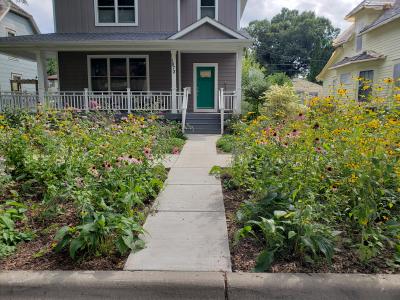Pollinator Toolbox
Lawns to Legumes
Wondering how to start your residential pollinator project?
Residential yards have huge potential as pollinator habitat. Converting a portion of a turf grass lawn to a pollinator planting can be intimidating. Many people just don't know where to start. This is why BWSR has developed resources to help you design, install and maintain your home pollinator planting. We also provide links to materials by other organizations partnering with us to support pollinators. These resources are being developed as part of BWSR's new Lawns to Legumes program, which will encourage planting residential lawns with native vegetation and pollinator friendly flowers and legumes to protect a diversity of pollinators.
D.I.Y resources
Why D.I.Y. Resources?
BWSR created these materials as a way to reach the most possible people to create quality pollinator habitat in Minnesota. The MN legislature created the Lawns to Legumes program to provide grants to homeowners converting their turf grass to pollinator planting, and the public response to this program has been amazing!
Many people who contacted BWSR were not looking for funding, but information about how to create pollinator habitat. We realized that some people just needed help getting started. We hope these free resources provide an important link for those who are not sure how to begin their pollinator planting project.
Planting for Pollinators habitat guide
Whether you are a seasoned gardener or completely new to planting, this guide offers information about pollinator needs, planting design, types of projects and maintenance. Contains information about choosing the best planting for your needs, and step-by-step design considerations to best benefit pollinators.
New accordion content
New accordion content
New accordion content
New accordion content
New accordion content
New accordion content
New accordion content
New accordion content
New accordion content
New accordion content
A guide to creating a safe yard for pollinators while preventing and dealing with common yard pest problems.
Pollinator Project Types
Before you begin a planting project, use this guide to make decisions about what type of project will work best in your yard and your lifestyle. Maintenance, installation ease, cost and aesthetic considerations are shown in these resources.
Preparing Your Soil: Easy prep with Compost or Mulch
Learn how to use sheet mulching to start preparing your garden for planting with the simple instructions below from Renaissance Soil. This is one of the most important steps towards a successful pollinator planting. Especially when converting turf, careful preparation can mean the difference between thriving native plants and overgrown weeds. Most of the time you will need to use some method to remove existing vegetation. Renaissance Soils fact sheets provide helpful tips for creating new garden beds using mulch or soil layers.
Pollinator Garden Templates:
Shady Garden, Rain Garden (Full Sun/moist soil), Sunny and Low Garden (Boulevard)
These templates provide base designs for native plant pollinator gardens, including boulevard and shade garden designs. They are customizable with substitutions for each plant.
Native Plants: Rusty patched bumble bee and other pollinator favorites here.
One of the best things you can do for pollinators is to provide blooms all season long. Some plants, like Wild Bergamot, are 'superfoods' for our bees. They provide amino-acid rich nectar and have immune-boosting effects. This is especially important as our bees are facing pressure from habitat loss, insecticides and fungicides and parasites and pathogens.
PLUS! Check out these great resources from our partner organizations:
NATIVE PLANTS for POLLINATORS
XERCES GREAT LAKES POLLINATOR PLANT LIST
QUESTIONS TO ASK YOUR NURSERY- POLLINATOR FRIENDLY ALLIANCE fact sheet
WILD ONES - lists: NATIVE PLANT NURSERIES AND LANDSCAPE SERVICES
METRO BLOOMS- DIY BEE LAWN and TURF ALTERNATIVES fact sheets
POLLINATOR FRIENDLY ALLIANCE - BEE LAWN fact sheet
XERCES SOCIETY-PROTECTING POLLINATORS AT HOME-Integrated pest management
XERCES SOCIETY NESTING & OVERWINTERING HABITAT GUIDE


